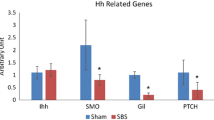Abstract
Purpose
Bone morphogenetic proteins (BMPs) are a group of growth factors that are implicated in intestinal growth, morphogenesis, differentiation, and homeostasis. The role of the BMP signaling cascade in stimulation of cell proliferation after massive small bowel resection is unknown. The purpose of this study was to evaluate the role of BMP signaling during intestinal adaptation in a rat model of short bowel syndrome (SBS).
Methods
Male rats were divided into two groups: Sham rats underwent bowel transection and SBS rats underwent a 75 % bowel resection. Parameters of intestinal adaptation, enterocyte proliferation and apoptosis were determined 2 weeks after operation. Illumina’s Digital Gene Expression analysis was used to determine the BMP signaling gene expression profiling. BMP-related genes and protein expression were determined using real-time PCR, Western blotting and immunohistochemistry.
Results
From the total number of 20,000 probes, 8 genes related to BMP signaling were investigated. From these genes, five genes were found to be up-regulated in jejunum (BMP1–10 %, BMP2-twofold increase, BMP3–10 %, BMP2R–12 % and STAT3–28 %) and four genes to be up-regulated in ileum (BMP1–16 %, BMP2–27 %, BMP3–10 %, and STAT3–20 %) in SBS vs sham animals with a relative change in gene expression level of 10 % or more. SBS rats also demonstrated a significant increase in BMP2 and STAT3 mRNA and protein levels (determined by real-time PCR and Western blot) compared to control animals.
Conclusion
Two weeks following massive bowel resection in rats, the BMP signaling pathway is stimulated. BMP signaling may serve as an important mediator of reciprocal interactions between the epithelium and the underlying mesenchymal stroma during intestinal adaptation following massive bowel resection in a rat.



Similar content being viewed by others
References
Martin GR, Wallace LE, Hartmann B, Holst JJ, Demchyshyn L, Toney K, Sigalet DL (2005) Nutrient-stimulated GLP-2 release and crypt cell proliferation in experimental short bowel syndrome. Am J Physiol Gastrointest Liver Physiol 288:G431–G438
O’Brien DP, Nelson LA, Huang FS, Warner BW (2001) Intestinal adaptation: structure, function, and regulation. Sem Pediatr Surg 10:55–64
De Santa BarbaraP, van den Brink GR, Roberts DJ (2003) Development and differentiation of the intestinal epithelium. Cell Mol Life Sci 2003(60):1322–1323
Hogan BL (1996) Bone morphogenetic proteins: multifunctional regulators of vertebrate development. Genes Dev 10:1580–1594
Bandyopadhyay A, Yadav PS, Prashar P (2013) BMP signaling in development and diseases: a pharmacological perspective. Biochem Pharmacol 85:857–864
Shroyer NF, Wong MH (2007) BMP signaling in the intestine: cross-talk is key. Gastroenterology 133:1035–1038
Hardwick JCH, van den Brink GR, Bleuming SA, Ballester I, van den Brande JMH, Keller JJ, Offerhaus GJA, van Deventer JH, Peppelenbosch MP (2004) Bone morphogenetic protein 2 is expressed by, and acts upon mature epithelial cells in the colon. Gastroenterology 126:111–121
Barker N (2008) The canonical Wnt/beta-catenin signalling pathway. Methods Mol Biol 468:5–15
Katoh M, Katoh M (2007) WNT signaling pathway and stem cell signaling network. Clin Cancer Res 13:4042–4045
Turashvili G, Bouchal J, Burkadze G, Kolar Z (2006) Wnt signaling pathway in mammary gland development and carcinogenesis. Pathobiology 73:213–223
Sukhotnik I, Roitburt A, Pollak Y, Dorfman T, Matter I, Mogilner JG, Bejar J, Coran AG (2014) Wnt/β-catenin signaling cascade down-regulation following massive small bowel resection in a rat. Pediatr Surg Int 30:173–180
He XC, Zhang J, Tong WG, Tawfik O, Ross J, Scoville DH, Tian Q, Zeng X, He X, Wiedemann LM, Mishina Y, Li L (2004) BMP signaling inhibits intestinal stem cell self-renewal through suppression of Wnt-beta-catenin signaling. Nat Genet 36:1117–1121
Sampath TK, Maliakal JC, Hauschka PV, Jones WK, Sasak H, Tucker RF (1992) Recombinant human osteogenic protein-1 (hOP-1) induces new bone formation in vivo with a specific activity comparable with natural bovine osteogenic protein and stimulates osteoblast proliferation and differentiation in vitro. J Biol Chem 267:20352–20362
Hogan BL (1996) Bone morphogenetic proteins: multifunctional regulators of vertebrate development. Genes Dev 10:1580–1594
Tang Y, Swietlicki EA, Jiang S, Buhman KK, Davidson NO, Burkly LC, Levin MS, Rubin DC (2006) Increased apoptosis and accelerated epithelial migration following inhibition of hedgehog signaling in adaptive small bowel postresection. Am J Physiol Gastrointest Liver Physiol 290(6):G1280–G1288
Ge C, Yang Q, Zhao G, Yu H, Kirkwood KL, Franceschi RT (2012) Interactions between extracellular signal-regulated kinase 1/2 and p38 MAP kinase pathways in the control of RUNX2 phosphorylation and transcriptional activity. J Bone Miner Res 27:538–551
Kosinski C, Li VS, Chan AS, Zhang J, Ho C, Tsui WY, Chan TL, Mifflin RC, Powell DW, Yuen ST, Leung SY, Chen X (2007) Gene expression patterns of human colon tops and basal crypts and BMP antagonists as intestinal stem cell niche factors. Proc Natl Acad Sci U S A 104:15418–15423
Author information
Authors and Affiliations
Corresponding author
Rights and permissions
About this article
Cite this article
Sukhotnik, I., Berkowitz, D., Dorfman, T. et al. The role of the BMP signaling cascade in regulation of stem cell activity following massive small bowel resection in a rat. Pediatr Surg Int 32, 169–174 (2016). https://doi.org/10.1007/s00383-015-3829-2
Accepted:
Published:
Issue Date:
DOI: https://doi.org/10.1007/s00383-015-3829-2




